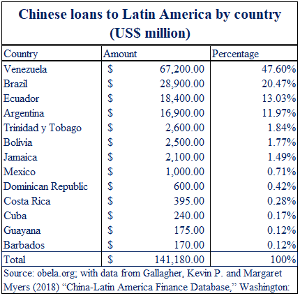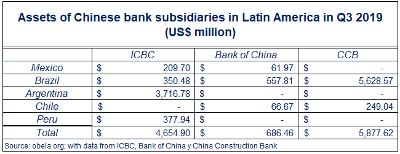China's expansion in Latin America is not limited to trade, investment, and clean energy, as financing the region becomes increasingly important. The Cooperation Plan (2015-2019) of the China-CELAC Forum, seeks to "take full advantage of the China - Latin America and the Caribbean Cooperation Fund, the Special Credit for China - Latin America and the Caribbean Infrastructure, the lines of credit on preferential terms offered by China." It also states her will to "strengthen cooperation [...] through financial institutions for development in the region" (more information). This intention gives rise to the insertion of the Chinese financial system in Latin America.

There are now two forms of financing for Latin America by the Chinese giant: couno de Carlos Fuentes y otro de Cortázar.mmercial banking and development banking. As for the latter, between 2005 and 2018, there is a total of 141 billion dollars in loans to Latin American countries from the Export-Import Bank of China (Exim Bank) and the China Development Bank (CDB). Financing began in 2005 when the Exim Bank lent Jamaica $30 million for the construction of a stadium. The year with the most loans was 2010 with $35.6 billion, where the repair and restoration of the train system in Argentina for $10 billion over 19 years, stands out, among other projects.
The loans to Latin America are mainly for energy projects (69%) where hydroelectric plants in Ecuador, the solar park in Jujuy, and oil production in Brazil and Venezuela stand out. There are also loans for infrastructure (18%), others1 (11%), and mining (1%). The second most financed item, infrastructure, refers to the construction of bridges and roads throughout the region for communication and the movement of imported Chinese products and raw materials for export. The project to connect cities and ports is part of the New Silk Road that President Xi Jinping mentioned at the II China-CELAC ministerial meeting. "We will shape a new master plan for the joint construction of the Belt and Road Initiative and forge a trans-Pacific cooperation route," he said. We must bear in mind the environmental damage that these projects could generate in Latin America and the resulting adverse social movements.
On the other hand, the commercial banks present in Latin America are the Industrial and Commercial Bank of China (ICBC), the Bank of China, and the China Construction Bank (CCB), the three largest banks in the world, and Haitong Bank. The four banks are in Argentina, Brazil, Chile, Mexico, Panama, and Peru. Currently, these have two presentations: branches and subsidiaries. Bank branches report to the home financial system and have no capital base. In contrast, subsidiaries are independent and act as national banks. In Latin America, there are four branches and 12 subsidiaries.

The four branches are ICBC in Uruguay, Haitong Bank in Brazil, and Bank of China in Argentina and Panama. The subsidiaries are ICBC in Mexico, Brazil, Argentina and Peru, Bank of China in Mexico, Brazil and Chile, and CCB in Brazil, Chile, and Peru. For the third quarter of 2019, the total assets of the subsidiaries in the region amount to US$11.218 billion. ICBC Argentina and CCB Brazil stand out for having US$ 3.716 billion and US$ 5.626 billion in assets, respectively. ICBC bought Standard Bank of South Africa, which operated in Argentina in 2012, and in 2013 CCB bought BicBanco of Brazil, making its numbers grow. These were the first banks to arrive in the region.
In Mexico, the Chinese banks opened in 2016 and stand out for receiving few deposits from the general public and, instead, having large interbank deposits. After four years in Mexico, they do not provide consumer credit. In Chile, deposits and long-term loans are the main instruments handled by ICBC Chile and CCB Chile. In other countries, Chinese banks have large amounts of deposits from the general public and consumer credit.
However, the absence of commercial banks in countries such as Colombia, El Salvador, Bolivia, and Ecuador is remarkable given the volumes of trade and Chinese interest shown in those countries. In Colombia, it was proposed in 2016 that Bank of China would open a branch, but this never materialized. Similarly, in El Salvador, the president of the Central Bank mentioned, at the end of 2018, that office of Chinese banks would begin operations, but, to date, there are no branches.
However, the absence of commercial banking in countries such as Colombia, El Salvador, Bolivia, and Ecuador is surprising given the volumes of trade and Chinese interest previously shown in those countries. In Colombia, a branch of the Bank of China was supposed to open in 2016, but this never materialized. Similarly, in El Salvador, the president of the Central Bank mentioned, at the end of 2018, that branches of Chinese banks would begin operations, but, to date, they have not. In Ecuador, the federal government obtained a five-year, US$970 million loan to ICBC in 2016. There are no offices in that country of any of these banks.
China is reaffirming its interest in the region by expanding financing to Latin American countries. With this, the search for Chinese hegemony takes another step forward by financing and building projects that help the New Silk Road in Latin America. Likewise, the existence of subsidiaries facilitates the entry of Chinese companies for the continued expansion of their products in Latin America.
1 The satellite in Bolivia, the financing of the fiscal deficit in Ecuador and the transport system in different countries stand out.









